
Costume or fashion jewelry includes a range of decorative items worn for personal adornment that are manufactured as less expensive ornamentation to complement a particular fashionable outfit or garment as opposed to "real" (fine) jewelry, which is more costly and which may be regarded primarily as collectibles, keepsakes, or investments. From the outset, costume jewelry — also known as fashion jewelry — paralleled the styles of its more precious fine counterparts.

Diamond is a solid form of the element carbon with its atoms arranged in a crystal structure called diamond cubic. Diamond as a form of carbon is tasteless, odourless, strong, brittle solid, colourless in pure form, a poor conductor of electricity, and insoluble in water. Another solid form of carbon known as graphite is the chemically stable form of carbon at room temperature and pressure, but diamond is metastable and converts to it at a negligible rate under those conditions. Diamond has the highest hardness and thermal conductivity of any natural material, properties that are used in major industrial applications such as cutting and polishing tools. They are also the reason that diamond anvil cells can subject materials to pressures found deep in the Earth.
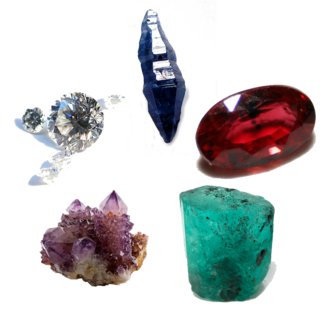
A gemstone is a piece of mineral crystal which, when cut or polished, is used to make jewelry or other adornments. Certain rocks and occasionally organic materials that are not minerals may also be used for jewelry and are therefore often considered to be gemstones as well. Most gemstones are hard, but some softer minerals such as brazilianite may be used in jewelry because of their color or luster or other physical properties that have aesthetic value. However, generally speaking, soft minerals are not typically used as gemstones by virtue of their brittleness and lack of durability.

Jewellery consists of decorative items worn for personal adornment such as brooches, rings, necklaces, earrings, pendants, bracelets, and cufflinks. Jewellery may be attached to the body or the clothes. From a western perspective, the term is restricted to durable ornaments, excluding flowers for example. For many centuries metal such as gold often combined with gemstones, has been the normal material for jewellery, but other materials such as glass, shells and other plant materials may be used.

An engagement ring, also known as a betrothal ring, is a ring indicating that the person wearing it is engaged to be married, especially in Western cultures. A ring is presented as an engagement gift by a partner to their prospective spouse when they propose marriage to represent a formal agreement to future marriage. In most Western countries, engagement rings are usually worn only by women, and they are typically adorned with diamonds. In some countries, partners wear matching rings, and engagement rings may also be used as wedding rings. In the Anglosphere, the ring is customarily worn on the left hand ring finger, but customs vary across the world.

Ruby is a pinkish red to blood-red colored gemstone, a variety of the mineral corundum. Ruby is one of the most popular traditional jewelry gems and is very durable. Other varieties of gem-quality corundum are called sapphires. Ruby is one of the traditional cardinal gems, alongside amethyst, sapphire, emerald, and diamond. The word ruby comes from ruber, Latin for red. The color of a ruby is due to the element chromium.
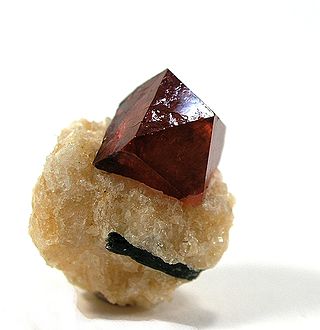
Zircon is a mineral belonging to the group of nesosilicates and is a source of the metal zirconium. Its chemical name is zirconium(IV) silicate, and its corresponding chemical formula is ZrSiO4. An empirical formula showing some of the range of substitution in zircon is (Zr1–y, REEy)(SiO4)1–x(OH)4x–y. Zircon precipitates from silicate melts and has relatively high concentrations of high field strength incompatible elements. For example, hafnium is almost always present in quantities ranging from 1 to 4%. The crystal structure of zircon is tetragonal crystal system. The natural color of zircon varies between colorless, yellow-golden, red, brown, blue, and green.

Cubic zirconia (abbreviated CZ) is the cubic crystalline form of zirconium dioxide (ZrO2). The synthesized material is hard and usually colorless, but may be made in a variety of different colors. It should not be confused with zircon, which is a zirconium silicate (ZrSiO4). It is sometimes erroneously called cubic zirconium.
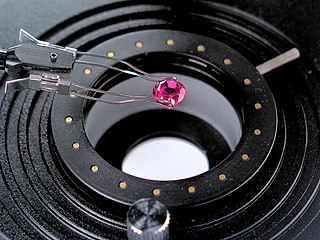
Gemology or gemmology is the science dealing with natural and artificial gemstone materials. It is a specific interdisciplinary branch of mineralogy. Some jewelers are academically trained gemologists and are qualified to identify and evaluate gems.

Zirconium dioxide, sometimes known as zirconia, is a white crystalline oxide of zirconium. Its most naturally occurring form, with a monoclinic crystalline structure, is the mineral baddeleyite. A dopant stabilized cubic structured zirconia, cubic zirconia, is synthesized in various colours for use as a gemstone and a diamond simulant.

Moissanite is naturally occurring silicon carbide and its various crystalline polymorphs. It has the chemical formula SiC and is a rare mineral, discovered by the French chemist Henri Moissan in 1893. Silicon carbide or moissanite is useful for commercial and industrial applications due to its hardness, optical properties and thermal conductivity.

QVC is an American free-to-air television network and a flagship shopping channel specializing in televised home shopping, owned by Qurate Retail Group. Founded in 1986 by Joseph Segel in West Chester, Pennsylvania, United States, QVC broadcasts to more than 350 million households in seven countries, including channels in the UK, Germany, Japan, and Italy, along with a joint venture in China with China National Radio called CNR Mall.

Tiffany & Co. is an American luxury jewelry and specialty design house headquartered on Fifth Avenue in Manhattan. Tiffany is known for its luxury goods, particularly its sterling silver and diamond jewelry. These goods are sold at Tiffany stores, online, and through corporate merchandising. Its name and branding are licensed to Coty for fragrances and to Luxottica for eyewear.

A diamond simulant, diamond imitation or imitation diamond is an object or material with gemological characteristics similar to those of a diamond. Simulants are distinct from synthetic diamonds, which are actual diamonds exhibiting the same material properties as natural diamonds. Enhanced diamonds are also excluded from this definition. A diamond simulant may be artificial, natural, or in some cases a combination thereof. While their material properties depart markedly from those of diamond, simulants have certain desired characteristics—such as dispersion and hardness—which lend themselves to imitation. Trained gemologists with appropriate equipment are able to distinguish natural and synthetic diamonds from all diamond simulants, primarily by visual inspection.
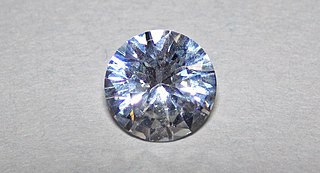
Yttrium aluminium garnet (YAG, Y3Al5O12) is a synthetic crystalline material of the garnet group. It is a cubic yttrium aluminium oxide phase, with other examples being YAlO3 (YAP) in a hexagonal or an orthorhombic, perovskite-like form, and the monoclinic Y4Al2O9 (YAM).
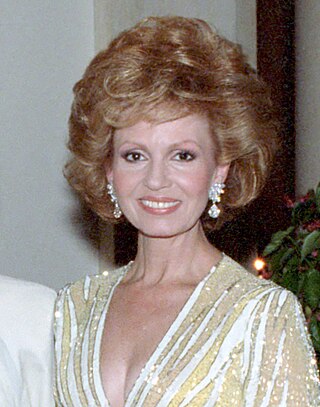
Tova Traesnaes Borgnine was a Norwegian-born American businesswoman. She was the founder of Beauty by Tova cosmetics and the widow of Hollywood actor Ernest Borgnine.
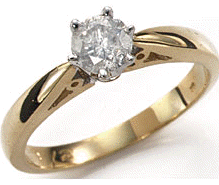
Prong setting or prong mount refers to the use of metal projections or tines, called "prongs", to secure a gemstone to a piece of jewelry. A prong setting is one component of what is known to jewelers as a head, a claw-shaped type of binding that is welded or soldered to a jewelry item to mount a gemstone to the jewelry item. A common setting for diamond engagement rings, the prong setting allows light to strike a gemstone from more angles, increasing its brilliance.
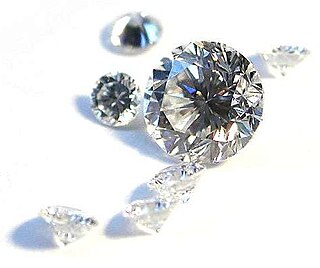
Diamond is a gemstone formed by cutting a raw diamond. Diamonds are one of the best-known and most sought-after gems, and they have been used as decorative items since ancient times.
Wellington Jewels was a Washington, D.C.–based jewelry store and direct mail chain, operating from the 1960s through the 1990s. The jewelry store chain specialized in artificial diamond jewelry and sold high-quality gold and platinum settings containing imitation gems, marketed by Mac and Helen Ver Standig's elaborate and highly successful advertising as prominently-labeled "counterfeit diamonds.".

The Shelby Gem Factory was the production facility of ICT Incorporated, a company in Shelby, Michigan, United States, that manufactured artificial gemstones through proprietary processes. ICT began operations in 1970 and closed in December 2019.


















